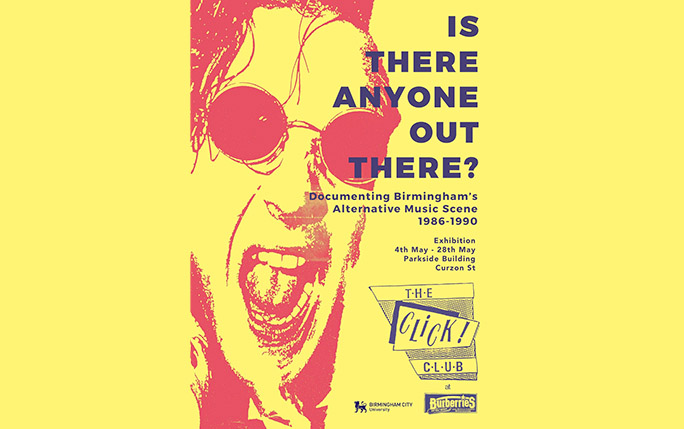Is There Anyone Out There'? Documenting Birmingham's Alternative Music Scene 1986-1990
Posted on: 21 June 2016 by Jez Collins in Posts

Jez Collins is a PhD student affiliated to the IPM and conducting research on popular music heritage and archives.
Through my work as the founder of the Birmingham Music Archive (BMA), I’ve collaborated with colleagues from the Birmingham Centre for Media and Cultural Research (BCMCR) to co-curate an exhibition, hosted at Birmingham City University, about an alternative music venue and disco called The Click Club: 'Is There Anyone Out There'? Documenting Birmingham’s Alternative Music Scene 1986-1990 (4-28 May 2016, Parkside Building, Birmingham City University). For this blog post though I thought I would give some context about what we are trying to achieve by having this exhibition and how we might think about it in terms of impact. To start with the BMA, the impact I’d like to see is relatively straightforward. Through the lifecycle of the exhibition and beyond, I’d like to see an increase in people engaging with the BMA, either by posting comments and materials to the site, or asking me to create new entries for people, places and spaces that are missing, offering new insights and new stories about Birmingham’s music heritage. I’d also like to create new partnerships and new collaborations, and encourage more people to take an active part in running and sustaining the BMA.
For BCMCR, we need to draw out impact in more meaningful ways, encouraging visitors to engage with the exhibition on a different level. In order to achieve this we have a number of students working on the project and, in particular, on the night of the launch event when we expect to host the most visitors at any one time. We are challenging our students to think critically about the event so that when they speak to visitors and receive feedback they can engage and extend the discussion in order to elicit more detailed feedback that we can then use for a range of activities (impact assessment being one of them). So part of our brief to student reads:
When we talk about impact we mean how the exhibition relates to the ways in which our approach to research, and its insights and practice, transforms people’s lives.
The nature of this transformation is what we are seeking to track in capturing:
how did they know about it? (through which channels, online vs. offline etc.)
reach of the current exhibition (who got to know about it and who are the direct and indirect beneficiaries?)
engagement (who attended or read the materials produced for the exhibition?)
impact (what changed for individuals as a result of engaging with the exhibition, and how has this change been expressed and manifested?)
While there are those interested in the exhibition because they were original participants in the scene that it captures, the audience we seek to reach can be defined as widely as possible, encompassing all demographics. Those who will be particularly important, however, can be identified as those whose interests and activities are far removed from the generic qualities of the exhibition material.
Working with colleagues in BCMCR’s Monitoring and Evaluation Lab we will be following up on engagement with the exhibition, not just in the physical space itself but also across a wide range of social media and online platforms and of course in the press.
Established in 1986 by Dave Travis and Steve Coxon, The Click Club was the name of a concert venue and disco associated with Birmingham’s alternative music culture. Located in ‘Burberries’, a conventional nightclub site in the pre-regeneration city centre, the club showcased a wide variety of acts reflecting the varied culture of the independent and alternative sector. While capacity was limited to a few hundred attendees on any one night, The Click Club was important locally, nationally and internationally for the role it played as part of a touring circuit, and for distributors and retailers of independent music. As a central feature in a music scene operating on a DIY-basis, independent of major labels and at the intersection of subcultures it also had enormous cultural value for its participants.
Travis continues to be a key cultural entrepreneur. Known initially as a professional photographer, commissioned by music publications such as NME, Sounds and the local Brumbeat amongst others, he has combined his photographic work with the promotion of live music in the city. The exhibition draws upon Travis’ personal archive of film, posters, magazines and ephemera that detail a vibrant and dynamic space and time in the late 1980s Birmingham. Central to the exhibition is a set of previously unseen images taken by Travis at The Click Club. The exhibition draws upon first-hand accounts of those who frequented the club and includes loaned artefacts in order to contextualize The Click Club in a historical moment that remains important to its community and to the music and cultural heritage of Birmingham. It poses a series of questions: what is the value of this material? what does it tell us beyond confirming the memories of the individuals it concerned? does such material have wider importance and contributions to make to our understanding of the past?
The exhibition was conceived and curated by scholars from the Birmingham Centre for Media and Cultural Research Paul Long, Jez Collins (founder of Birmingham Music Archive), and Sarah Raine.
Keywords: impact, research, phd, heritage, archives, birmingham, call for participation.